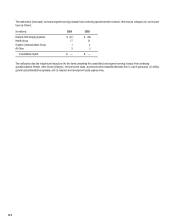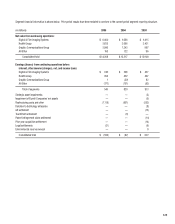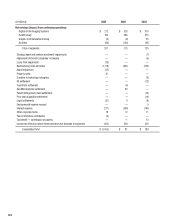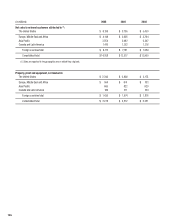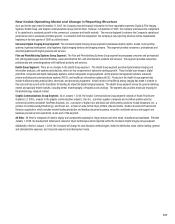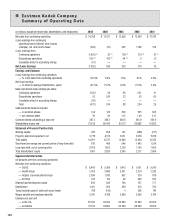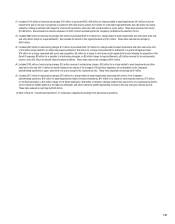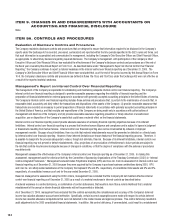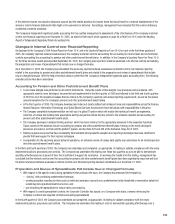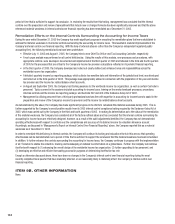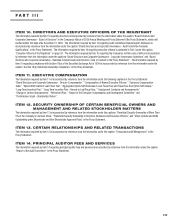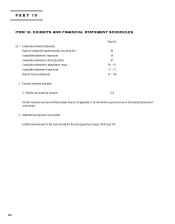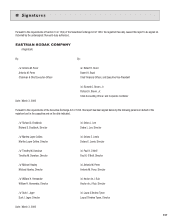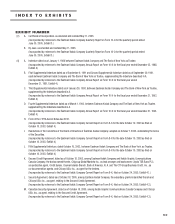Kodak 2005 Annual Report Download - page 134
Download and view the complete annual report
Please find page 134 of the 2005 Kodak annual report below. You can navigate through the pages in the report by either clicking on the pages listed below, or by using the keyword search tool below to find specific information within the annual report.132
ITEM 9. CHANGES IN AND DISAGREEMENTS WITH ACCOUNTANTS ON
ACCOUNTING AND FINANCIAL DISCLOSURE
None.
ITEM 9A. CONTROLS AND PROCEDURES
Evaluation of Disclosure Controls and Procedures
The Company maintains disclosure controls and procedures that are designed to ensure that information required to be disclosed in the Company’s
reports under the Exchange Act is recorded, processed, summarized and reported within the time periods specifi ed in the SEC’s rules and forms, and
that such information is accumulated and communicated to management, including the Company’s Chief Executive Offi cer and Chief Financial Offi cer,
as appropriate, to allow timely decisions regarding required disclosure. The Company’s management, with participation of the Company’s Chief
Executive Offi cer and Chief Financial Offi cer, has evaluated the effectiveness of the Company’s disclosure controls and procedures as of the end of
the fi scal year covered by this Annual Report on Form 10-K. As described below under “Management’s Report on Internal Control Over Financial
Reporting,” the Company continues to report a material weakness in the internal control over fi nancial reporting as of December 31, 2005. The
Company’s Chief Executive Offi cer and Chief Financial Offi cer have concluded that, as of the end of the period covered by this Annual Report on Form
10-K, the Company’s disclosure controls and procedures (as defi ned in Rules 13a-15(e) and 15d-15(e) under the Exchange Act) were not effective as
a result of the reported material weakness.
Management’s Report on Internal Control Over Financial Reporting
The management of the Company is responsible for establishing and maintaining adequate internal control over fi nancial reporting. The Company’s
internal control over fi nancial reporting is designed to provide reasonable assurance regarding the reliability of fi nancial reporting and the
preparation of fi nancial statements for external purposes in accordance with generally accepted accounting principles in the United States of America.
The Company’s internal control over fi nancial reporting includes those policies and procedures that: (i) pertain to the maintenance of records that, in
reasonable detail, accurately and fairly refl ect the transactions and dispositions of the assets of the Company; (ii) provide reasonable assurance that
transactions are recorded as necessary to permit preparation of fi nancial statements in accordance with generally accepted accounting principles in
the United States of America, and that receipts and expenditures of the Company are being made only in accordance with authorizations of
management and directors of the Company; and (iii) provide reasonable assurance regarding prevention or timely detection of unauthorized
acquisition, use or disposition of the Company’s assets that could have a material effect on the fi nancial statements.
Internal control over fi nancial reporting cannot provide absolute assurance of achieving fi nancial reporting objectives because of its inherent
limitations. Internal control over fi nancial reporting is a process that involves human diligence and compliance and is subject to lapses in judgment
or breakdowns resulting from human failures. Internal control over fi nancial reporting also can be circumvented by collusion or improper
management override. Because of such limitations, there is a risk that material misstatements may not be prevented or detected on a timely basis
by internal control over fi nancial reporting. However, these inherent limitations are known features of the fi nancial reporting process. Therefore, it
is possible to design into the process safeguards to reduce, though not eliminate, this risk. Because of its inherent limitations, internal control over
fi nancial reporting may not prevent or detect misstatements. Also, projections of any evaluation of effectiveness to future periods are subject to
the risk that controls may become inadequate because of changes in conditions, or that the degree of compliance with the policies or procedures
may deteriorate.
Management assessed the effectiveness of the Company’s internal control over fi nancial reporting as of December 31, 2005. In making this
assessment, management used the criteria set forth by the Committee of Sponsoring Organizations of the Treadway Commission (COSO) in “Internal
Control-Integrated Framework.” Management excluded Kodak Polychrome Graphics (KPG) and Creo Inc. from its assessment of internal control over
fi nancial reporting as of December 31, 2005 because they were acquired by the Company in purchase business combinations during 2005. KPG
and Creo Inc. are wholly owned subsidiaries of the Company that represent 9% and 8%, respectively, of consolidated total assets and 9% and 3%,
respectively, of consolidated revenue as of and for the year ended December 31, 2005.
Based on management’s assessment using the COSO criteria, management has concluded that the Company did not maintain effective internal
control over fi nancial reporting as of December 31, 2005 as a result of a material weakness in internal controls as described below.
A material weakness is a control defi ciency, or combination of control defi ciencies, that results in more than a remote likelihood that a material
misstatement of the annual or interim fi nancial statements will not be prevented or detected.
As of December 31, 2005, management has concluded that the controls surrounding the completeness and accuracy of the Company’s deferred
income tax valuation allowance account were ineffective. Specifi cally, certain incorrect assumptions were made with respect to certain deferred
income tax valuation allowance computations that were not detected in the related review and approval process. This control defi ciency resulted in
audit adjustments to the 2005 consolidated fi nancial statements. In addition, this control defi ciency, if unremediated, could result in a misstatement


